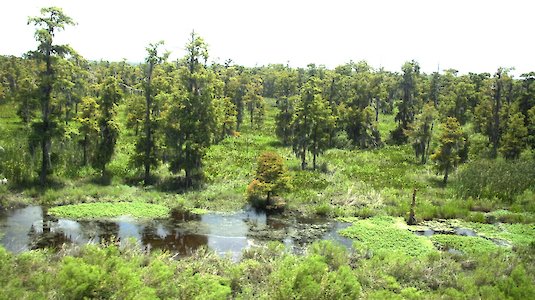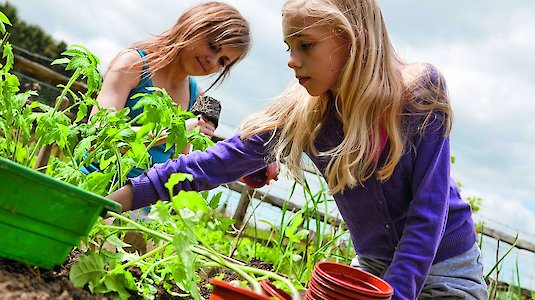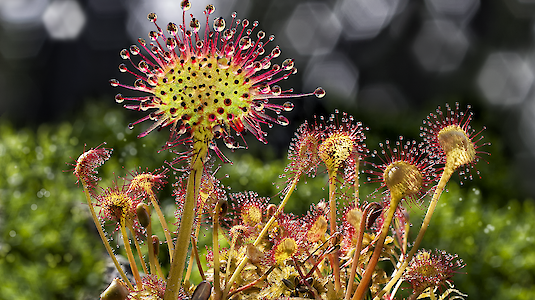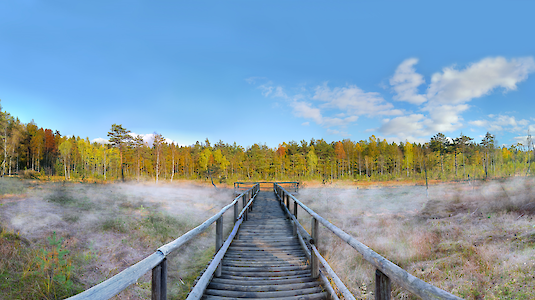Protect natural cycles
Peatlands are among the most endangered habitats in Europe. They are home to highly specialized animals and plants, are huge reservoirs of greenhouse gases and have an aesthetic as well as spiritual value!
Bogs are among the most endangered habitats in Europe. They are home to highly specialized flora and fauna, such as the carnivorous sundew, various orchids and dragonflies, such as the high-moor mosaic damselfly. Peat mosses form the basis for these species. Peat is formed from their dying plant remains under exclusion of air; whereby a thickness of two meters requires about 2000 years.
"Bogs are wetlands, on whose mostly spongy soils peculiar vegetations form characteristic biotopes. Constant excess water from precipitation or from escaping mineral soil water keeps the soil low in oxygen and prevents the complete decomposition of plant remains, which are instead deposited as peat. This distinguishes them from bogs, which occasionally dry out, so their organic matter is completely degraded to humus. Living bogs grow upward through peat growth." [1]

Only three percent of the world's land is bog land. Despite this small area, peatlands are enormous greenhouse gas reservoirs and important factors in the fight against climate change. Large quantities of greenhouse gases are permanently removed from the atmosphere; globally twice as much (!) as by the biomass of the forests. The extraction of these fossil raw materials takes only a short time and is the most important single source of greenhouse gases in our latitudes outside the energy sector. Peat extraction not only irreversibly destroys nature, but also removes stored CO2 from the soil. White peat in particular, which is added to our potting soils, can only be extracted along a very narrow, northern band of the earth. Therefore, it is not available in unlimited quantities.
Moors in trade!
Peatlands are unique natural and living spaces. Nevertheless, peatlands are lost every year in Europe: about 64 million cubic meters of peat are extracted annually. Of the 64 million cubic meters, half goes to energy production and half to horticulture.
The peat use listed in more detail:
- 50% energy
- 42% potting soil and growing media
- 5% soil conditioner
- 3% Others
The Austrian Ecolabel has had random surveys carried out in garden centers, DIY stores and analysis of web offers from substrate manufacturers and found that only eleven percent of products are peat-free. 89 percent of the substrates available on the market contain peat, with a mixed proportion of 80 to 90 percent. Although peat is not mined in Austria itself, we import large quantities of it every year.

To ensure that this habitat is preserved and that we can meet our increased responsibilities in the age of the Anthropocene, the Austrian Ecolabel for Horticulture developed Guidline UZ 32 "Peat-free growing medium, soil additives, fertilizers and composts."
Peat-free is nature conservation
Nature conservation is a concern for many people. Conscious gardeners in particular want to expand nature's habitat and not contribute to its destruction. There are no weed killers in the grass, no pesticides on the vegetables and no peat in the flowerbed. But it is not so easy to buy peat-free soil.
Look out for the Austrian Ecolabel! In addition to high-quality products, their use also protects beautiful natural jewels, inhibits the extinction of species (according to the latest report of the World Biodiversity Council (IPBES), one million species are threatened with extinction in the coming years and decades), prevents the release of further greenhouse gases and is part of a circular economy whose model holds many solutions for the future.

Note, an organic label does not guarantee peat-free. The use of the term "organic" for potting soil is not covered by any legal regulation, and only about half of the soils that carry an organic label are peat-free.
Only the Austrian Ecolabel and the EU Ecolabel for growing media and soil improvers guarantee peat-free potting soil and do not use other exhaustible starting materials, they avoid energy-rich synthetic fertilizers and recycle plant and animal residues.
[1] https://de.wikipedia.org/wiki/Moor
DIE UMWELTBERATUNG - Peat-free soils: https://www.umweltberatung.at/bluetenpracht-aus-torffreier-erde
Renaturation and nature conservation concepts for wetlands: https://www.bmk.gv.at/themen/klima_umwelt/naturschutz/vielfaltleben/schutzprojekte/abgeschlossen/flora.html
IG Moorschutz: https://igmoorschutz.at/
IPBES #PandemicsReport: https://ipbes.net/pandemics
